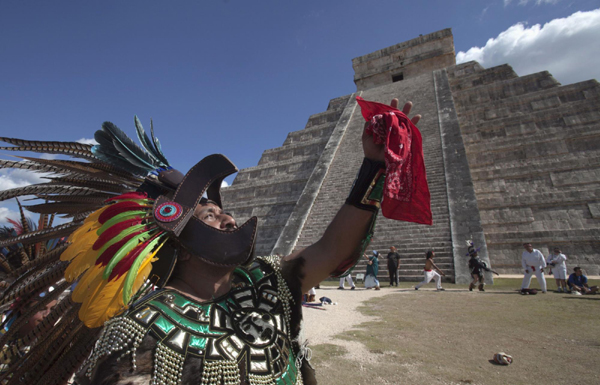UFO lovers, light-seekers await Maya end of days
(Agencies) Updated: 2012-12-21 09:52CHICHEN ITZA, Mexico - As pockets of anxiety crop up ahead of the day billed as the Maya apocalypse, a motley crew of New Age thrill-seekers, mystics and tourists have gathered at ancient holy sites in Mexico hoping to witness the birth of a new era.
In the Maya Long Calendar, Dec 21 marks the end of the 13th bak'tun, an epoch lasting roughly 400 years.
In the 1960s, one respected US academic said the event might signify a possible "Armageddon" to the Mesoamerican culture, and the belief that Friday could be the world's last day has spread since.
But to many of the artists, hippies, lawyers and businessmen congregating in the nerve center of 12/21/2012 - the Maya ruins of Chichen Itza in southern Mexico - the day will be the culmination of a spiritual journey, the dawn of a new consciousness, or the wellspring of untapped energies.
Or even all the above.
"There is an explosion of consciousness through this," said Shambala Songstar, a gray-haired Californian musician who gave his age as "eternal."
"We are becoming billionaires of energy. Opening to receive more light and more joy," he said.
In other parts of the world, fears that Dec 21 may bring doom, or unleash lesser disasters, has sparked scares.
On Thursday, Chinese state media said about 1,000 people had been detained for spreading rumors about Friday, such as the prospect of a three-day-long blackout.
The crackdown, which targeted members of the "Almighty God" cult, has not been enough to stem shortages of candles, instant noodles and matches, according to complaints logged on Weibo, China's popular Twitter-like microblogging site.
In France, the media has buzzed about the Pic de Bugarach, a mountain said by believers in an impending catastrophe to be the only place that will survive 2012.
Social media spread fears that a mass suicide was being planned on a mountain popular among UFO spotters in Argentina. Local authorities decided to limit access to the Cerro Uritorco peak, though they said it was to prevent overcrowding.
A cornerstone of the 2012 phenomenon has been US scholar Michael Coe's 1966 observation that the end of the 13th bak'tun could herald an "Armageddon" for the Maya. Coe could not be reached for comment, but friends and colleagues say he never meant to forecast an apocalypse.
NASA, other scientists and other experts on Maya culture have also dismissed the idea of disaster striking, but media rumors and Internet fascination with the subject have put the spotlight on the sweltering heartland of the ancient civilization.
Thousands of people are expected in Chichen Itza, where pilgrims will converge on the Temple of the serpent god Kukulkan, an imposing 100 foot (30 meter) pyramid.
Visitors have come from as far afield as Asia, Europe and South America to share in the experience, and there is little apprehension among them that the world faces a day of reckoning in the annals of the Maya's 5,125 year-old calendar.
"At least we can die saying we saw the end of the world," said 27-year-old Minu Nair from Kerala, India, laughing and bathed in sweat after a steep climb to the top of the Maya pyramid at Coba, about an hour's drive from Chichen Itza.
Special:
Doomsday doomed?







